CONUNDRUMS TO SOLVE FOR THE BRITISH AND SWISS
Flat water and a light sea-breeze gave INEOS Britannia a perfect blank canvas in Barcelona today to start digging into a conundrum that’s bothered the team since the arrival of their second AC40 for the two-boat race practise programme. What’s been spotted but not publicly acknowledged until today is the very slight speed differential that the new boat has over the AC40 that the team used in the two Preliminary Regattas in 2023.
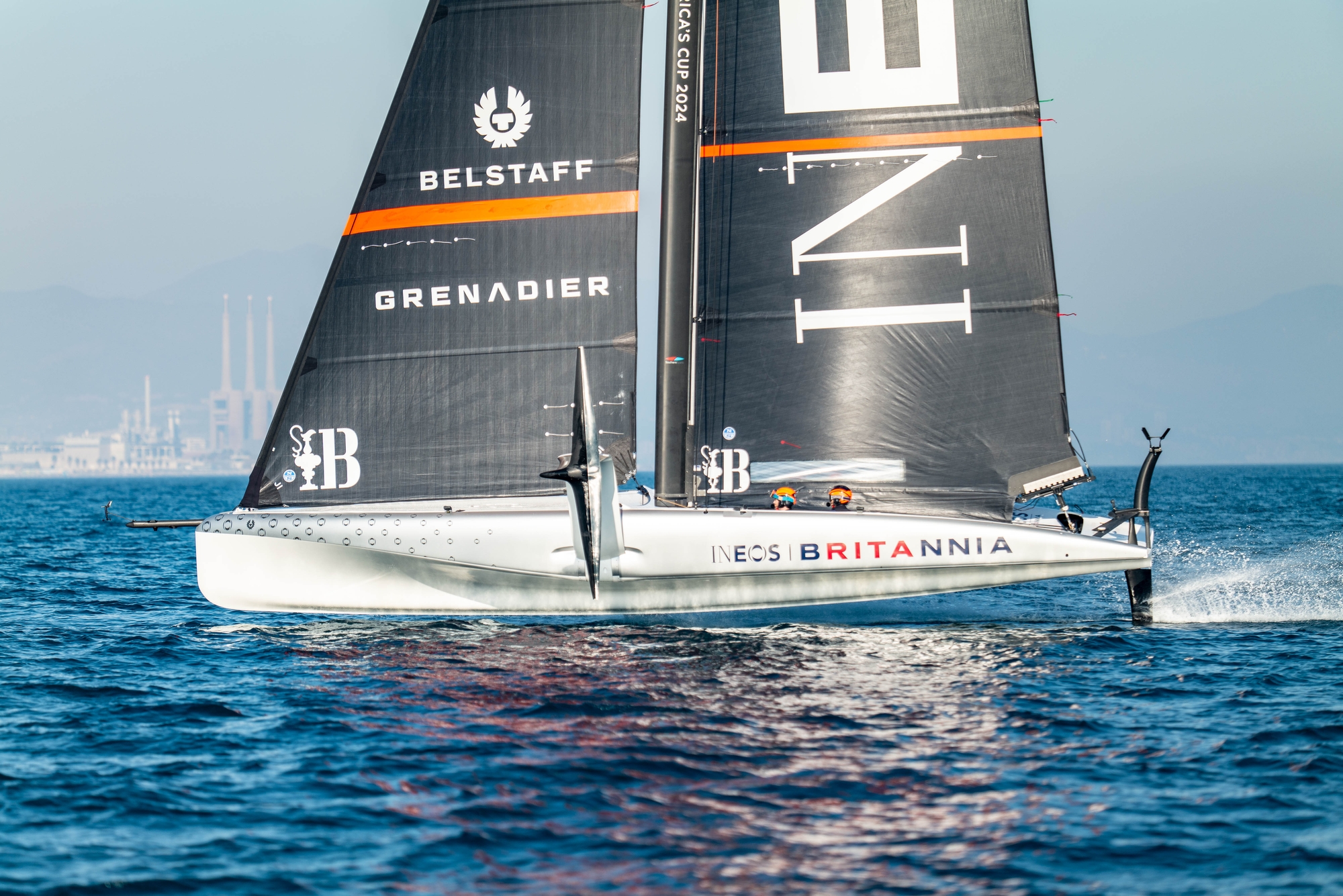
Today, in marginal, lower-end test conditions, it was again ‘Boat B’ – or ‘Sienna’ – that held the upper hand with Sir Ben Ainslie and Giles Scott winning most of the pre-starts and speed tests over what appeared to be a marginally horsepower-struggling ‘Boat A’ with Dylan Fletcher-Scott and Ben Cornish driving.

The team were trialling a new triangular topped, low aspect J2 jib that they switched between boats with little difference spotted by the recon team and Ben acknowledged the speed issue in interview afterwards saying: “We are seeing a little bit of difference between the boats which is interesting from a one-design class perspective but yeah I think we need more time with this other headsail to figure out how it's going, we switched it between boats but it's hard to tell really...we’re trying to figure out what's causing that difference so we’re lining up the boats and making sure that everything is symmetric in terms of foil arm positions, rig and the systems on the boat to see if there's any differences there. For us it's really important to try and figure out what's making that difference because that will help us understand these boats in general.”

And Ben, also wryly commented: “I think we're seeing that ‘Boat B’ is just a click faster than ‘Boat A’ so yeah, I guess I wish we had ‘Boat B’ earlier in the year.” The mystery of the speed differential is something that this highly technical, data-driven team will, for sure, get to the bottom of and the results could be extremely important to their overall campaign.
Speaking about the new J2 headsail, Ben also made a very interesting comment that alluded to perhaps how prized the team might favour manoeuvrability over outright speed in the AC75 in a very tight Challenger Series, as he said: “It's also about the functionality of the sails as well. We know here in Barcelona that it's very variable conditions so you kind of want sails that are going to give you that variability, that ability to adapt to conditions, and mode changes, so there’s maybe more to it than just straight-line speed.” Interesting period for INEOS Britannia with plenty of learning going on all round and plenty for the Mercedes Applied Science analysts to dig into back at ‘Mission Control.’
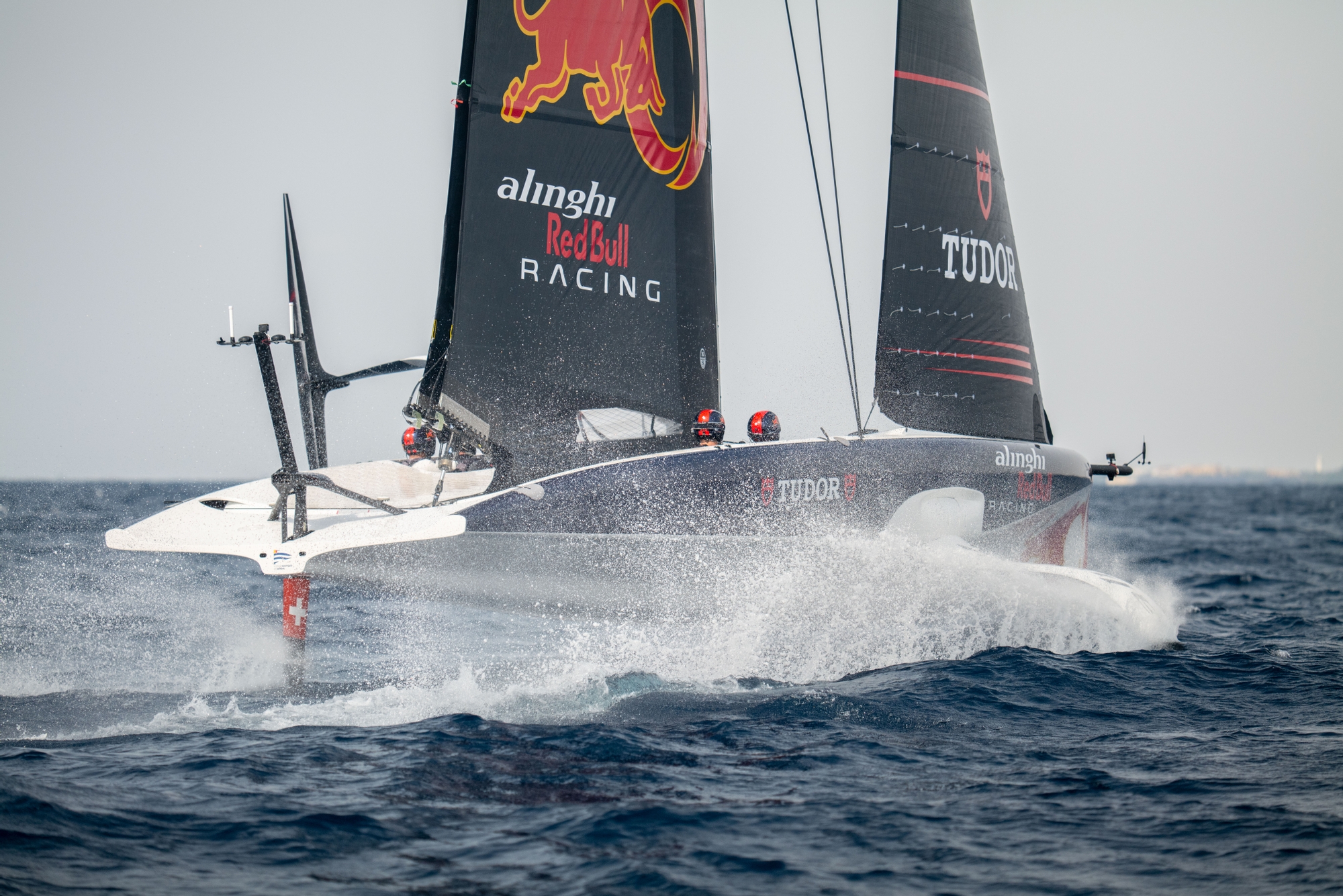
Meanwhile over in Jeddah, Saudi Arabia, it was slightly lighter conditions for the Alinghi Red Bull Racing two-boat programme than the all-out extreme master-blasting of yesterday’s session. An opportunity therefore to concentrate on the aero packages with the two AC40’s featuring full LEQ12 sets of in-house designed and built sails and two very different mainsails trading high aspect ratio off against a low aspect ratio set-up to set forth a very interesting conundrum of their own making.

The sailmakers’ theory being that the higher aspect (long, thin and tapering to a finer head) might produce more outright speed in a straight-line, especially in higher wind-speeds, whereas the lower aspect (with greater volume towards the head) be both more stable and manoeuvrable in the key pre-start sequence, especially in lower wind-speeds. Choose the conditions, pick your style – that’s powerful.

Certainly, in the lighter airs of around 10 knots that greeted the sailors, it was all in favour of the lower aspect rigged ‘Black’ boat with Arnaud Psarofaghis and Jason Waterhouse steering initially but as the session went on and the afternoon breeze filled it became almost too close to tell with some desperately close racing. Nicolas Charbonnier and Maxime Bachelin paired up on the ‘Red’ boat and after assessing the characteristics of the new sail, built in confidence through the five hour session where some 145 manoeuvres were recorded (minimum) for the ‘Black’ boat – at a staggering 94% foil-to-foil ratio. That’s progress.
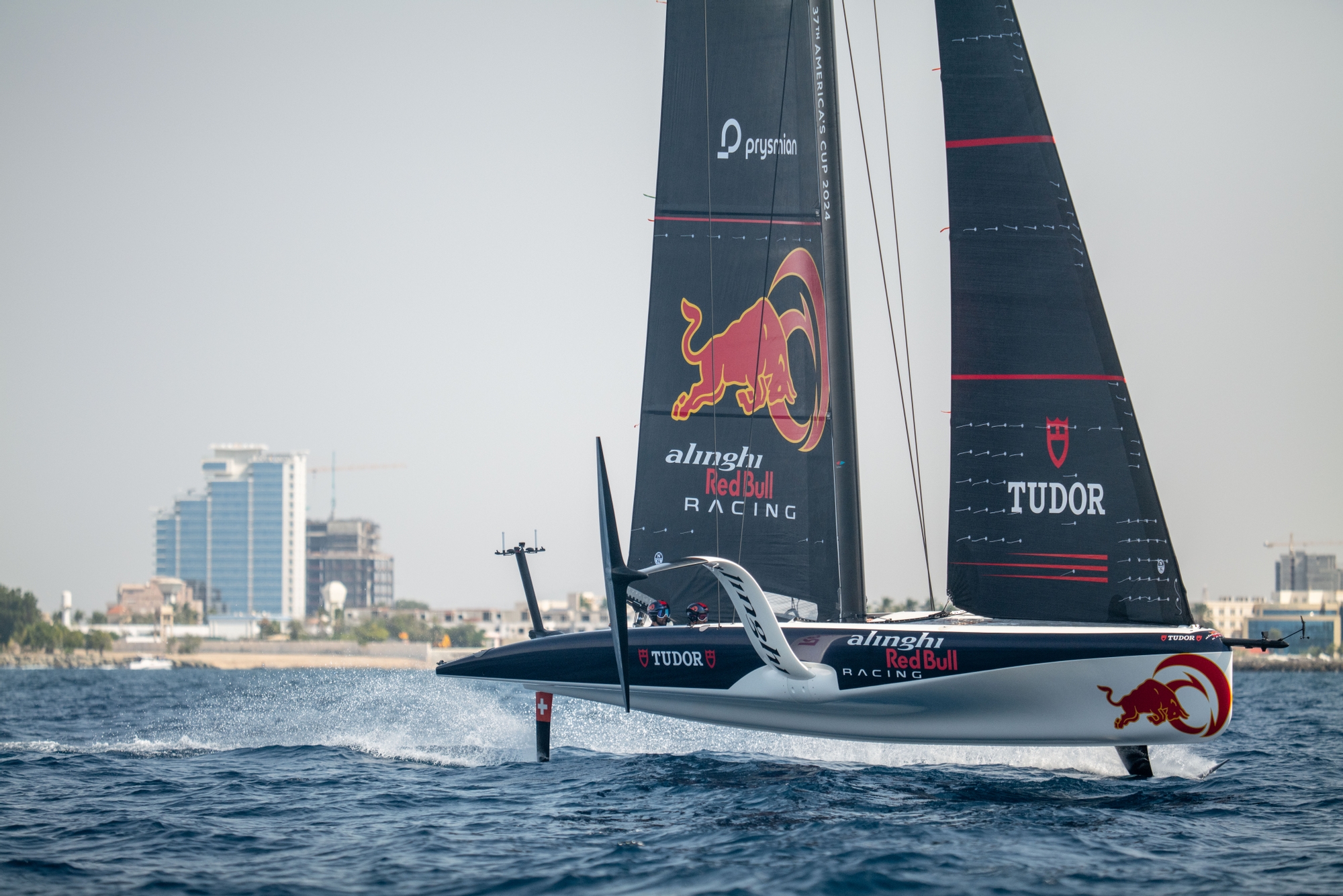
Once again, the race execution and technique of both Swiss boats was from another planet and as spectators we were treated to absolutely no-holds barred racing with desperately tight crosses, ducks, lee-bows, slam dunks, JKs, single board round ups, luffs – you name it, it was all there on display on the Red Sea. At the top marks, every trick in the book came out when the two boats were neck and neck and at the leeward mark, such is the confidence in the sailing team at the moment that they were throwing the boats around like Go-Karts. A real step-on in technique from the Preliminary Regatta held in Jeddah less than a couple of months’ ago.
Speaking afterwards, Lucien Cujean, a key member of the Flight Control/Trim team at Alinghi Red Bull Racing commented on the sail differences saying: “There is some difference for sure, but then in the moment it's quite hard to see which one is faster than the other so yeah I think as you see on the water it's a lot of boat handling and you have to nail the boat handling before making any conclusions... I think it's hard to make any conclusion, like we really need to sit down and having a proper debrief and let the team analysing our stuff and then we will really see which one won the day.”
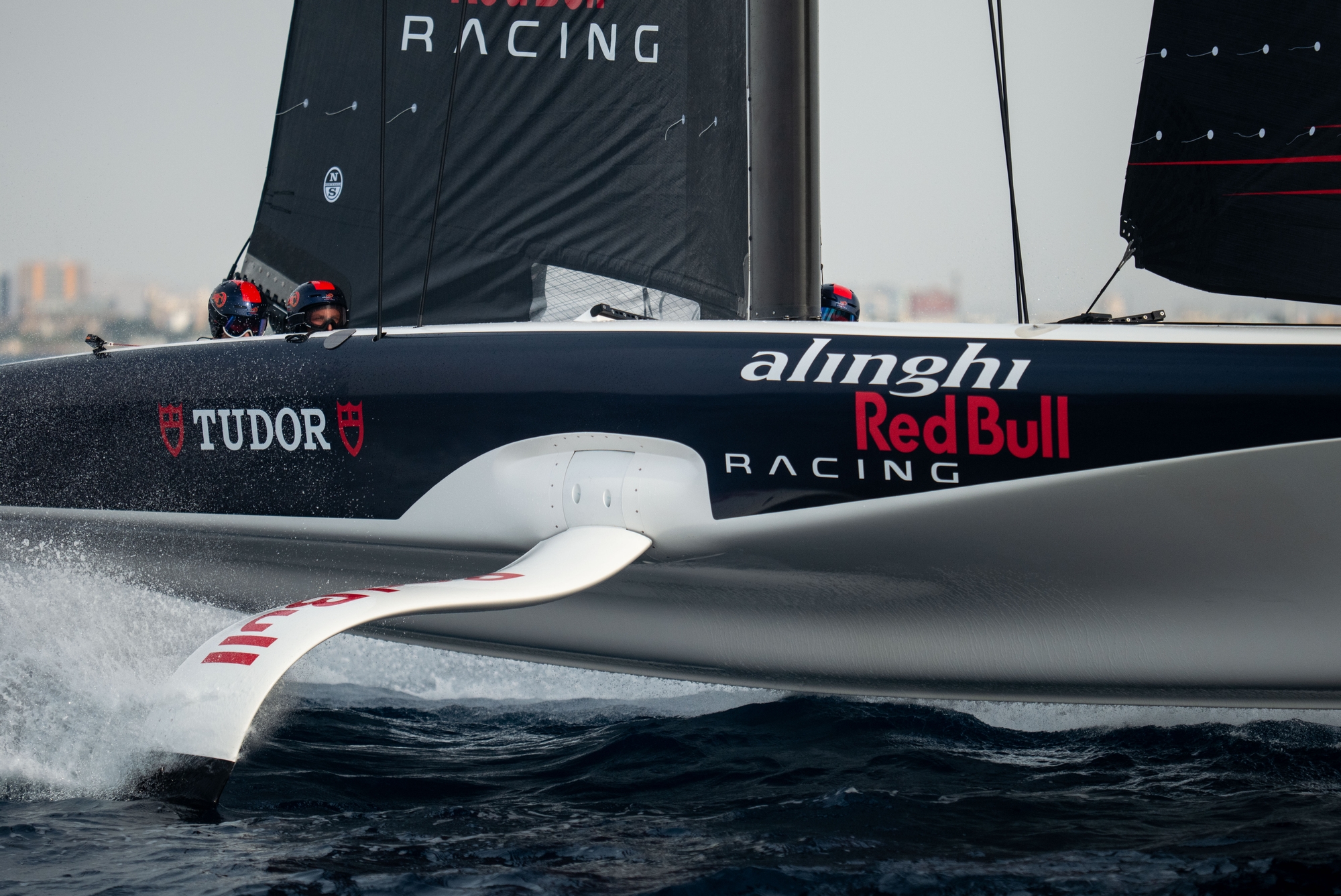
That debrief will be fascinating and for the data analysts and coaches, understanding the variances of the high and low aspect mainsail could be key come the heat of battle in the Louis Vuitton Cup round robins in September in variable Barcelona. Alinghi Red Bull Racing’s time on the Red Sea has proven to be a very valuable boost on the learning curve all round. Great sailing from the Swiss. (Magnus Wheatley)
On-Water Recon Report – INEOS Britannia: Team IB craned to the water their two AC40s, Sienna(b) and Athena(a), at 09.54am and 10.08am, respectively, in one-design foil configuration. Both boats had been left out of the shed with their masts up overnight. The team docked out just after 12:00, as planned.

At 12:10 one-design mainsails and J1s were hoisted while exiting the port. However, the wind intensity was not strong enough to start the training, reason why the team was forced to wait for approximately one hour and a half just outside the harbour.
At 13:45 finally the south-westerly sea-breeze kicked in, allowing the session to begin. Both boats headed towards the racing area, were an upwind-downwind course was set.
Four, one-lap, upwind-downwind races were carried out in marginal 5 to 8 knots conditions, with each boat executing three to four tacks and gybes per leg, respectively. The two boats alternated the starboard and port entries. AC40(b) had a solid performance, starting ahead, rounding the top marks ahead, and winning the four races.
Race two was the closest one, in which both boats rounded the bottom gates almost at the same time. Race four was also close, with AC40(a) finishing less than 10 seconds behind.
After the fourth race at 15:15, the J1s were replaced by a one-design J2 onboard AC40(b) and by the new LEQ12_J2-4 on AC40(a). Ten minutes after, both boats started to speed test upwind. One long upwind and downwind were carried out, on both tacks, with both boats switching sides. Differences were small, however, AC40(b) using the one-design J2 was slightly faster both upwind and downwind, with a greater margin on the downwind.
At 16:10 both jibs were lowered and then switched. AC40(a) hoisted the one-design J2, while AC40(b) put the new LEQ12_J2-4 probably to test and eliminate any possible human and boat bias. On the upwinds AC40(b) continued to seem to have something extra. However, differences were smaller than before switching jibs. On the downwind and specially on port tack, AC40(a) with the one-design jib was slightly faster.
Just before entering the port, both boats headed back to the racecourse area and did one more start and race, possibly to test differences in performance in between both jibs while manoeuvring during the pre-start. All these in bottom range J2 conditions.
At 17:20 AC40(b) entered the port and started to drop both sails. AC40(a) followed ten minutes after. By 17:50 both boats were on the dock, and at 18:00 AC40(b) was the first of the two boats to be craned out of the water indicating the end of the day. Sebastian Peri Brusa – Recon on INEOS Britannia
On-Water Recon Report – Alinghi Red Bull Racing: Alinghi Red Bull Racing rolled out their AC40-7 (Black) and AC40-4 (Red) at 09:15 and 09:40, with the focus of the day on sail testing and match-racing. Both boats were in the water by 10:00. GoPros were fixed to wands at the top of the mast on the Red boat. Work was carried out at the mast base, this could have been a simple repair, but not certain. Further work was carried out on linked controls, with the electronics tech seen working on traveller movement and mast rotation.
The boats were prepared with LE mainsails and jibs, with the Red boat helmed by Nico Charbonnier and Maxime Bachelin, and the Black boat by Arnaud Psarofaghis and Jason Waterhouse. Dock-out times were staggered at 12:00 for Black and 12:05 for Red. The Red boat hoisted the M1-1 LE sail, first time seen this trip, with notably less sail area, tapered in at the head. The J2-3 LE jib was hoisted next. The Black boat hoisted the M1-3 LE sail, seen previously this trip, as well as the J2-2 LE jib. Sea-state conditions gradually developed from a relatively flat sea state to a mild chop.
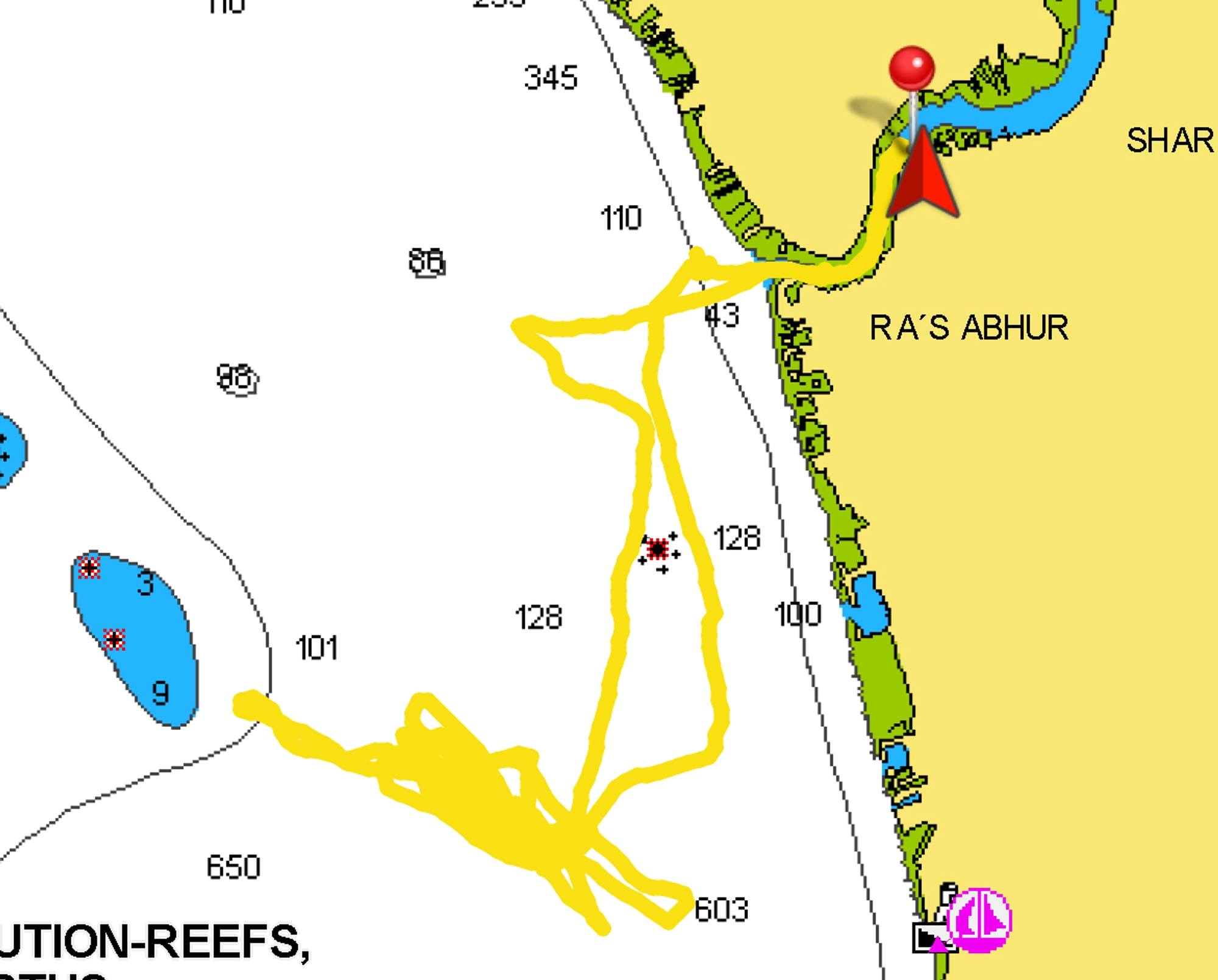
Stint 1 (12:38 - 12:55, 8-10.5kn 290° @ 12:40) Both boats started with independent sail testing, followed by sailing in parallel and split gybes.
Stint 2 (12:59 - 13:13, 8-11.5kn 295° @ 12:55) The stint progressed with split tacks upwind, leading to competitive tacks towards the stationary windward chase boat. The boats then rounded to starboard and sailed downwind with split gybes, finishing with a competitive gybe battle to the course start.
Stint 3 (13:20 - 13:42, 9-14kn 300° @ 13:25) Three match racing starts were practiced, with the third start leading to a 1 lap race around the 1NM course, set at 320. All starts saw Red entering on port and Black on starboard. Black won the race, with Red touching down as they attempted a gybe round the leeward gate, flying too high on entry. Following this stint, Black dropped the J2 and hoisted the J3-1 LE.
Stint 4 (13:50 - 14:24, 13-16.5kn 305° @ 13:55, 14-18kn 320° @ 14:15) The following three starts (Start 4-6) saw Black enter on port. The third start continued to a 1 lap race (Race 1) around the course, which was led from start to finish by the Black boat. Following the stint, Red dropped the J2 and prepared the J3-2 LE, with techs below deck before hoisting the jib.
Stint 5 (14:45 - 15:33, 13-17kn 325° @ 14:50, 11-15kn 320° @ 15:10) The Black boat sailed a few practice starts while Red resolved persisting issues, before joining at 15:10. With wind increasing, two more starts (Start 7-8) were sailed with Black entering on port, Red on starboard. The second start continued into a 1 lap race (Race 2), which was won by Red who overtook upwind, leading from the windward mark to the finish. Following the race, a full crew swap was carried out between the two boats.
Stint 6 (15:45 - 16:11, 11-14.5kn 320° @ 15:45) As the wind conditions slightly eased, the teams warmed up independently in their new boats, with a short upwind/downwind ahead of racing. Two starts followed (Start 9-10), with the last start continuing on to a 1 lap race (Race 3), which was won from start to finish by the Red boat, after a close tacking battle to the windward mark.
Stint 7 (16:15 - 16:25, 12-16.5kn 325° @ 16:15) The final stint of the day saw the team sail back to base, after mixing up the crew. Sails were dropped by 16:35 at the entrance of the Obhur Creek.
The day on the water concluded after nearly five hours of intensive training, with 170 minutes of sailing time. A total of 145 manoeuvres were observed of the Red boat, with a 94% fully foiling rate, marking the most manoeuvres observed in a day on the AC40s to date.